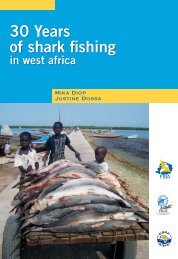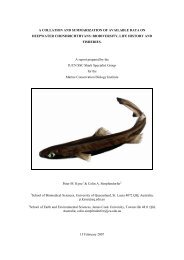Magazine of the species survival Commission specialist Group - IUCN
Magazine of the species survival Commission specialist Group - IUCN
Magazine of the species survival Commission specialist Group - IUCN
Create successful ePaper yourself
Turn your PDF publications into a flip-book with our unique Google optimized e-Paper software.
<strong>specialist</strong> group exchange<br />
with land use changes due to<br />
agricultural intensification. The <strong>species</strong><br />
now occurs at very low densities and a<br />
recent study has identified an emerging<br />
potential threat to its long-term <strong>survival</strong>.<br />
Following <strong>the</strong> discovery <strong>of</strong><br />
naturalised populations <strong>of</strong> <strong>the</strong> European<br />
Hare (Lepus europaeus), <strong>the</strong> Irish Hare<br />
Species Action Plan Steering <strong>Group</strong><br />
commissioned a review, funded by <strong>the</strong><br />
Nor<strong>the</strong>rn Ireland Environment Agency<br />
(NIEA), <strong>of</strong> <strong>the</strong> potential impact <strong>of</strong> <strong>the</strong><br />
invader on <strong>the</strong> native sub<strong>species</strong>.<br />
The paper, published in Biological<br />
Invasions, suggests that European<br />
Hares establish easily beyond <strong>the</strong>ir<br />
native range and exhibit strong<br />
competition for habitat space and food<br />
resources with native <strong>species</strong>, including<br />
non-lagomorphs. However, <strong>the</strong>ir effect<br />
on similar <strong>species</strong>, such as <strong>the</strong><br />
Mountain Hare, can be even more<br />
damaging. The Irish Hare represents an<br />
evolutionarily unique lineage among <strong>the</strong><br />
mountain hares having been isolated<br />
post-glacially for some 30,000–60,000<br />
years. The discovery <strong>of</strong> interspecific<br />
hybridization between invading<br />
European and native Irish hares in <strong>the</strong><br />
wild in Ireland is, <strong>the</strong>refore, very<br />
worrying. Moreover, <strong>the</strong> review warns<br />
that disease, parasite transmission and<br />
climate change may provide an edge to<br />
<strong>the</strong> invading <strong>species</strong> at <strong>the</strong> expense <strong>of</strong><br />
<strong>the</strong> native.<br />
A panel <strong>of</strong> Lagomorph SG members<br />
provided a signed foreword to<br />
accompany <strong>the</strong> paper recommending<br />
immediate intervention. An urgent call<br />
was issued for more research and for<br />
<strong>the</strong> drafting <strong>of</strong> a European Hare Invasive<br />
Species Action Plan (ISAP) and<br />
Eradication Strategy. Invasive mammal<br />
<strong>species</strong> have been successfully<br />
removed from Ireland before and<br />
immediate action is <strong>of</strong>ten <strong>the</strong> only<br />
opportunity for cost-effective<br />
eradication. Read more at<br />
www.quercus.ac.uk.<br />
Neil Reid<br />
Contributor and member <strong>of</strong> Lagomorph<br />
Specialist <strong>Group</strong><br />
Andrew Smith<br />
Chair, Lagomorph Specialist <strong>Group</strong><br />
Medicinal Plant SG<br />
Revised standards for sustainable<br />
management <strong>of</strong> medicinal plants<br />
The International Standard for<br />
Sustainable Wild Collection <strong>of</strong> Medicinal<br />
and Aromatic Plants (ISSC-MAP),<br />
developed by <strong>the</strong> Medicinal Plant<br />
Specialist <strong>Group</strong> in collaboration with<br />
<strong>the</strong> German Federal Agency for Nature<br />
Conservation (BfN), TRAFFIC, and<br />
WWF, has now merged with <strong>the</strong><br />
FairWild Standard in <strong>the</strong> recently<br />
released version 2.0. A commitment to<br />
join <strong>the</strong> two wild-collection standard<br />
initiatives under <strong>the</strong> ownership and<br />
management <strong>of</strong> <strong>the</strong> FairWild Foundation<br />
was formalized in 2008 during <strong>the</strong> 4th<br />
<strong>IUCN</strong> World Conservation Congress in<br />
Barcelona.<br />
FairWild Standard version 2.0<br />
combines ecological, social, and<br />
economic good practice principles for<br />
sustainable wild collection <strong>of</strong> natural<br />
ingredients for food, cosmetics, herbal<br />
remedies and pharmaceuticals.<br />
Globally, more than 400,000 tonnes<br />
<strong>of</strong> medicinal and aromatic plants are<br />
traded annually, with <strong>the</strong> great majority<br />
<strong>of</strong> <strong>the</strong>se <strong>species</strong> being harvested from<br />
<strong>the</strong> wild. Out <strong>of</strong> an estimated 50,000–<br />
70,000 plant <strong>species</strong> used medicinally<br />
world-wide, around 15,000 are thought<br />
to be threatened by over-exploitation<br />
and habitat loss.<br />
The revised FairWild Standard and<br />
related performance indicators combine<br />
all essential elements <strong>of</strong> <strong>the</strong> original<br />
FairWild Standard, focused on fair<br />
trade, and <strong>the</strong> International Standard for<br />
Sustainable Wild Collection <strong>of</strong> Medicinal<br />
and Aromatic Plants (ISSC-MAP),<br />
which focused on ecological<br />
sustainability and applications to<br />
traditional knowledge, access and<br />
benefit sharing (ABS). Moreover, <strong>the</strong><br />
revised version incorporates <strong>the</strong><br />
lessons learned through practical<br />
application <strong>of</strong> <strong>the</strong> Standard in <strong>the</strong> field.<br />
The latest Standard was drawn up<br />
following extensive consultations with<br />
plant experts and representatives from<br />
<strong>the</strong> global herbal products industry.<br />
This year, 23 wild plant collection<br />
companies are on track to becoming<br />
FairWild certified.<br />
The FairWild Standard is useful not<br />
only for companies wishing to certify<br />
<strong>the</strong>ir products as sustainably traded.<br />
Earlier versions <strong>of</strong> <strong>the</strong> Standard are<br />
already being used by Government<br />
agencies in a number <strong>of</strong> countries as<br />
<strong>the</strong> basis <strong>of</strong> <strong>the</strong>ir natural resource<br />
management plans, <strong>the</strong>reby helping to<br />
fulfil <strong>the</strong>ir commitments to <strong>the</strong><br />
Convention on Biological Diversity,<br />
particularly those related to sustainable<br />
use <strong>of</strong> biodiversity, good practices for<br />
plant resource management, and<br />
equitable distribution <strong>of</strong> benefits from<br />
biodiversity resources.<br />
Danna Leaman<br />
Chair, Medicinal Plant Specialist <strong>Group</strong><br />
Otter SG<br />
Standardizing post-mortem protocol<br />
Biologists and veterinarians from across<br />
Europe ga<strong>the</strong>red in Denmark in<br />
February at a workshop arranged by<br />
<strong>the</strong> <strong>IUCN</strong> SSC Otter Specialist <strong>Group</strong>.<br />
The workshop aimed to produce a<br />
standardised post-mortem protocol,<br />
Eurasian Otter (Lutra lutra). © Hugh Jansmann<br />
<strong>species</strong> 52 • 23
















